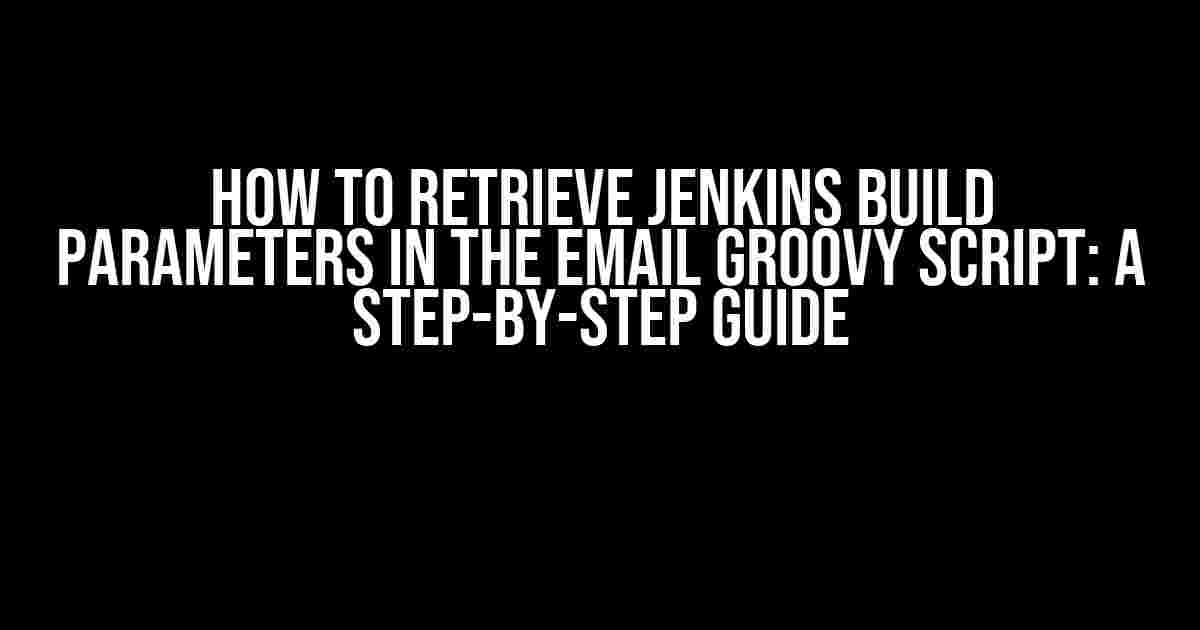Are you tired of manually entering build parameters in your Jenkins email notifications? Do you want to automate the process and make your life easier? Look no further! In this article, we’ll show you how to retrieve Jenkins build parameters in the email Groovy script, so you can focus on more important things.
The Importance of Jenkins Build Parameters
Jenkins build parameters are a crucial part of the build process. They allow you to customize your builds, trigger specific actions, and pass variables between steps. But what happens when you need to access these parameters in your email notifications? That’s where things can get tricky.
The Challenge: Retrieving Build Parameters in Email Scripts
By default, Jenkins doesn’t provide an easy way to access build parameters in email scripts. You might have tried using environment variables, but they’re not always reliable. You might have even tried using the `${BUILD_VARIABLE}` syntax, but it doesn’t work in email scripts.
So, what’s the solution? Enter Groovy scripts! With Groovy, you can write custom scripts that interact with the Jenkins API and retrieve build parameters. In this article, we’ll show you how to do just that.
Prerequisites
Before we dive into the tutorial, make sure you have the following prerequisites:
- Jenkins installed and configured
- Email Extension Plugin installed and configured
- Groovy plugin installed and configured
- Basic knowledge of Groovy scripting
Step 1: Create a New Email Notification
Create a new email notification in your Jenkins project. Go to the Post-build Actions section and click on the Add post-build action button. Select Email Notification from the dropdown menu.
 |
Step 2: Add a Groovy Script
In the email notification settings, click on the Advanced button. In the preprocessing script section, select Groovy as the script type.
<div>
<label>Preprocessing script</label>
<textarea rows="10" cols="50">
// Your Groovy script goes here
</textarea>
</div>
Step 3: Retrieve Build Parameters using Groovy
Now, it’s time to write the Groovy script that retrieves the build parameters. You can use the following code as a starting point:
import hudson.model.*
// Get the current build
def build = Thread.currentThread().getExecutable()
// Get the build parameters
def parameters = build.getAction(ParametersAction.class).getParameterMap()
// Iterate over the parameters and print their values
parameters.each { key, value ->
println "Parameter ${key} = ${value}"
}
This script gets the current build object, retrieves the build parameters using the getAction method, and iterates over the parameters using the each method.
Step 4: Access Build Parameters in the Email Script
Now that you have the build parameters, you can access them in your email script using the binding object. Here’s an example:
<p>Build Parameters:</p>
<ul>
<% binding.getVariables().each { key, value -> %>
<li>${key} = ${value}</li>
<% } %>
</ul>
This script uses the binding object to access the build parameters and prints them in an unordered list.
Step 5: Test Your Script
Save your changes and trigger a new build. Check your email notification to see if the build parameters are being retrieved correctly.
Troubleshooting Tips
If you’re having trouble retrieving build parameters, here are some troubleshooting tips:
- Check your Groovy script for syntax errors
- Verify that the build parameters are being passed correctly
- Check the Jenkins logs for errors
- Try using a different approach, such as using the
EnvInjectplugin
Conclusion
Retrieving Jenkins build parameters in email scripts can be a challenge, but with Groovy, it’s a breeze. By following this step-by-step guide, you can automate the process and make your life easier. Remember to test your script thoroughly and troubleshoot any issues that may arise.
Happy automating!
Frequently Asked Questions
Hey there, Jenkins enthusiasts! Are you tired of guessing how to retrieve those pesky build parameters in your email Groovy script? Worry no more, we’ve got you covered! Here are some frequently asked questions to get you up and running in no time.
Q: How do I retrieve build parameters in my email Groovy script?
You can access build parameters using the `params` object in your Groovy script. For example, if you have a parameter named `MY_PARAM`, you can retrieve its value using `params[‘MY_PARAM’]`. You can then use this value in your email script to customize the content.
Q: Can I retrieve built-in Jenkins parameters in my email script?
Absolutely! You can access built-in Jenkins parameters like `BUILD_NUMBER`, `JOB_NAME`, and `EXECUTOR_NUMBER` using the `env` object. For example, `env.BUILD_NUMBER` would give you the current build number.
Q: How do I iterate over multiple build parameters in my email script?
You can iterate over multiple build parameters using a `for` loop in your Groovy script. For example, `params.each { key, value -> println “$key = $value” }` would print out all the build parameters and their values.
Q: Can I use build parameters in conditional statements in my email script?
Yes, you can use build parameters in conditional statements like `if` and `switch` statements in your Groovy script. For example, `if (params[‘MY_PARAM’] == ‘true’) { … }` would execute a block of code if the `MY_PARAM` parameter is set to `true`.
Q: Are there any limitations to using build parameters in my email script?
One important limitation is that you can only access build parameters that are set before the email script is executed. If you’re trying to access a parameter that’s set later in the build process, it won’t be available in your script. Also, be mindful of security concerns when using build parameters, especially if they contain sensitive information.

